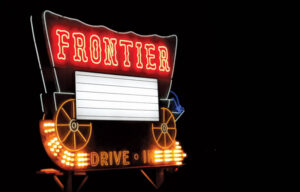By John Mattingly
The morning after a light snow is a revealing time to walk in the brush lands of the northern San Luis Valley. Fresh snow provides a relief map of the previous night’s activity, engaged in by other creatures that live here. The footprints of various rabbits and hares, mice and moles, numerous birds, raccoons and skunks, and occasionally deer and elk, pattern the snow under the slanted light of approaching winter. You might even see a bobcat or big cat track, on the rarest of occasions.
The light snows this fall have allowed us to track mice headed for tractors and vehicles, raccoons taking more than their share of duck food, and coyotes contemplating possibilities. Guard dogs discourage coyotes from action, but their tracks in the snow indicate that they remain curious and hopeful on the perimeter, just in case someone in the chain of command takes an untimely nap.
A furry crater in the snow can mean a couple of kinds of demise. Parallel coyote and rabbit tracks ending in the furry crater are easy to diagnose. On a rare occasion, I happened on four coyotes dividing a large hare by the draw-and-quarter system. They let their guard down from greed, allowing me to get closer than coyotes typically allow.
I did not have a rifle on that walk, and even if I did, I am not overly aggressive against coyotes because they control rabbits and gophers. There have been times after large coyote roundups when haystacks have been eaten from the bottom up by droves of hares, who multiplied quickly in the absence of predation. Nevertheless, on the occasion of the four coyotes dividing a hare, I would have taken a shot.
Once in a while, you come upon a furry crater surrounded by undisturbed snow, all around it for many feet. At first, this is baffling, until you get lucky one day and see a hare fold his ears back in the shadow of a bush, thinking he is invisible, only to be swooped down upon, plucked at the ears and nape by a golden eagle, then elevated suddenly while kicking every which way, and finally dropped to the ground from about two hundred feet into the resulting furry crater, wherein to be devoured by the eagle, or whoever arrives first.
Walking this landscape, it comes to mind that these creatures all live on what the sun gives them every day, month, year, decade. They do not have stored solar energy as a backup. This leads them to be especially thrifty, and the desert is a place where extreme thrift is needed for continuing life. In rain-fed country, there is some room for error, corrected by the next rain, but even in the lushest lands, creatures live on their annual solar dividend.
Human creatures used to do the same, prior to farming and the Industrial Revolution. Could we, would we, ever return to that same solar obedience?
Ian Morris’ book, “Why The West Rules—For Now” (The Patterns of History and What They Reveal About the Future) looks at Western Civilization beginning about 80,000 years ago, providing, among a host of other observations, a different origin story for human agriculture. Morris is a paleo archaeologist. Even though his research offers the same sort of interesting speculations about human culture found in “Sapiens” by Harari, Morris has some actual spade work behind his pages.
The popular story is that agriculture was invented about 10,000 years ago, as if it happened rather quickly during a spurt of human brain power due, perhaps, to consumption of animal proteins. Morris puts a broader brush on this theory. He theorizes that humans have been alternating between foraging and farming for a long time.
Though it’s impossible to do justice to Morris’ 750-page book in this column, his research indicates that, around 70,000 years ago, humans started to save seeds to be planted in concentrated areas, thus capturing more solar energy. Morris speculates that women were in charge of gathering the flora while men hunted the fauna. Women found that gathering was inefficient, as seeds matured at different times and different places. Saving favorite seeds and planting them close to the tribal base allowed them to increase their food supply and thus have more time and energy for offspring, producing and caring for them.
Adding manure and irrigation to the seed plots amplified the capture of solar energy by orders of magnitude, and from the Middle East to Northern Europe, the population of farming tribes grew rapidly. Drought, climate change or spoilage reduced the food supply, sending the farmers back to foraging. There they encountered the foragers who had resisted farming and now saw the farmers-turned-foragers as a threat to the total food supply. Wars and resolutions followed and were repeated over tens of thousands of years, time frames most of us seldom reconcile.
The back-and-forth between farming and foraging went on for millennia, until about 5,000 years ago when Earth’s climate tilted in favor of farming and the result is what we have today: industrialized agriculture and overpopulation. In the grand scheme of things, forces such as climate and disease could force humans to return to foraging. Every farming-based civilization of the past 70,000 years probably thought they had it all figured out, just as we do now. And maybe this time will be different; particularly as the adjustment back to foraging would require unimaginable alterations and suffering.
Still and all, it’s worth recalling the hare, who, nested in the shade of a bush with ears laid back, thought he was invisible.
John Mattingly cultivates prose, among other things, and was most recently seen near Moffat.
A Farmer Far Afield is sponsored by Cheryl Brown-Kovacic and Larry Kovacic.


